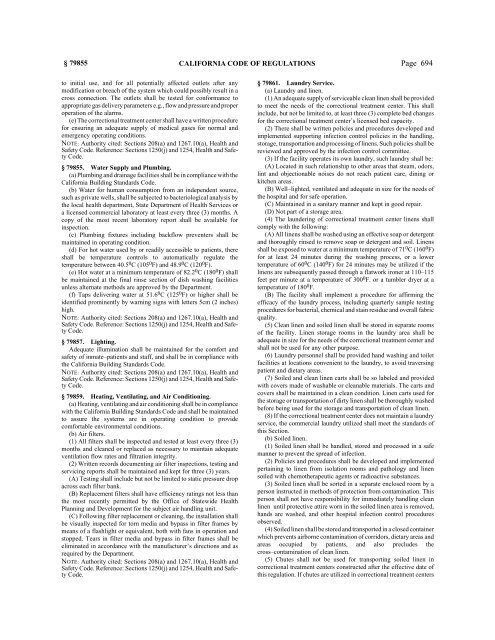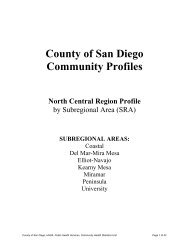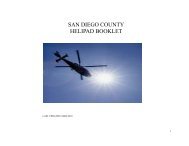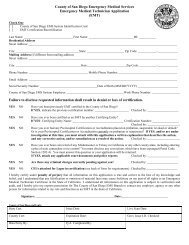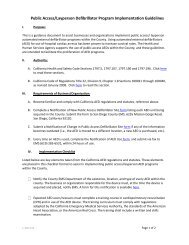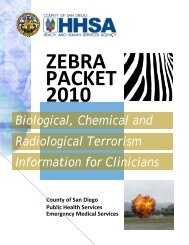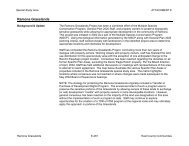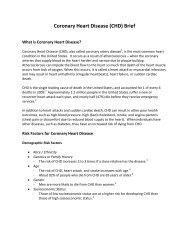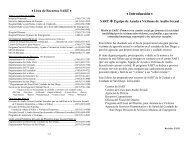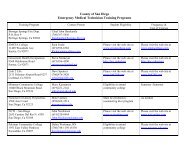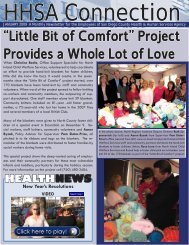CALIFORNIA CODE OF REGULATIONS - State of California
CALIFORNIA CODE OF REGULATIONS - State of California
CALIFORNIA CODE OF REGULATIONS - State of California
Create successful ePaper yourself
Turn your PDF publications into a flip-book with our unique Google optimized e-Paper software.
§ 79855 <strong>CALIFORNIA</strong> <strong>CODE</strong> <strong>OF</strong> <strong>REGULATIONS</strong><br />
Page 694<br />
to initial use, and for all potentially affected outlets after any<br />
modification or breach <strong>of</strong> the system which could possibly result in a<br />
cross connection. The outlets shall be tested for conformance to<br />
appropriate gas delivery parameters e.g., flow and pressure and proper<br />
operation <strong>of</strong> the alarms.<br />
(e) The correctional treatment center shall have a written procedure<br />
for ensuring an adequate supply <strong>of</strong> medical gases for normal and<br />
emergency operating conditions.<br />
NOTE: Authority cited: Sections 208(a) and 1267.10(a), Health and<br />
Safety Code. Reference: Sections 1250(j) and 1254, Health and Safety<br />
Code.<br />
§ 79855. Water Supply and Plumbing.<br />
(a) Plumbing and drainage facilities shall be in compliance with the<br />
<strong>California</strong> Building Standards Code.<br />
(b) Water for human consumption from an independent source,<br />
such as private wells, shall be subjected to bacteriological analysis by<br />
the local health department, <strong>State</strong> Department <strong>of</strong> Health Services or<br />
a licensed commercial laboratory at least every three (3) months. A<br />
copy <strong>of</strong> the most recent laboratory report shall be available for<br />
inspection.<br />
(c) Plumbing fixtures including backflow preventers shall be<br />
maintained in operating condition.<br />
(d) For hot water used by or readily accessible to patients, there<br />
shall be temperature controls to automatically regulate the<br />
temperature between 40.5 0 C (105 0 F) and 48.9 0 C (120 0 F).<br />
(e) Hot water at a minimum temperature <strong>of</strong> 82.2 0 C (180 0 F) shall<br />
be maintained at the final rinse section <strong>of</strong> dish washing facilities<br />
unless alternate methods are approved by the Department.<br />
(f) Taps delivering water at 51.6 0 C (125 0 F) or higher shall be<br />
identified prominently by warning signs with letters 5cm (2 inches)<br />
high.<br />
NOTE: Authority cited: Sections 208(a) and 1267.10(a), Health and<br />
Safety Code. Reference: Sections 1250(j) and 1254, Health and Safety<br />
Code.<br />
§ 79857. Lighting.<br />
Adequate illumination shall be maintained for the comfort and<br />
safety <strong>of</strong> inmate–patients and staff, and shall be in compliance with<br />
the <strong>California</strong> Building Standards Code.<br />
NOTE: Authority cited: Sections 208(a) and 1267.10(a), Health and<br />
Safety Code. Reference: Sections 1250(j) and 1254, Health and Safety<br />
Code.<br />
§ 79859. Heating, Ventilating, and Air Conditioning.<br />
(a) Heating, ventilating and air conditioning shall be in compliance<br />
with the <strong>California</strong> Building Standards Code and shall be maintained<br />
to assure the systems are in operating condition to provide<br />
comfortable environmental conditions.<br />
(b) Air filters.<br />
(1) All filters shall be inspected and tested at least every three (3)<br />
months and cleaned or replaced as necessary to maintain adequate<br />
ventilation flow rates and filtration integrity.<br />
(2) Written records documenting air filter inspections, testing and<br />
servicing reports shall be maintained and kept for three (3) years.<br />
(A) Testing shall include but not be limited to static pressure drop<br />
across each filter bank.<br />
(B) Replacement filters shall have efficiency ratings not less than<br />
the most recently permitted by the Office <strong>of</strong> <strong>State</strong>wide Health<br />
Planning and Development for the subject air handling unit.<br />
(C) Following filter replacement or cleaning, the installation shall<br />
be visually inspected for torn media and bypass in filter frames by<br />
means <strong>of</strong> a flashlight or equivalent, both with fans in operation and<br />
stopped. Tears in filter media and bypass in filter frames shall be<br />
eliminated in accordance with the manufacturer’s directions and as<br />
required by the Department.<br />
NOTE: Authority cited: Sections 208(a) and 1267.10(a), Health and<br />
Safety Code. Reference: Sections 1250(j) and 1254, Health and Safety<br />
Code.<br />
§ 79861. Laundry Service.<br />
(a) Laundry and linen.<br />
(1) An adequate supply <strong>of</strong> serviceable clean linen shall be provided<br />
to meet the needs <strong>of</strong> the correctional treatment center. This shall<br />
include, but not be limited to, at least three (3) complete bed changes<br />
for the correctional treatment center’s licensed bed capacity.<br />
(2) There shall be written policies and procedures developed and<br />
implemented supporting infection control policies in the handling,<br />
storage, transportation and processing <strong>of</strong> linens. Such policies shall be<br />
reviewed and approved by the infection control committee.<br />
(3) If the facility operates its own laundry, such laundry shall be:<br />
(A) Located in such relationship to other areas that steam, odors,<br />
lint and objectionable noises do not reach patient care, dining or<br />
kitchen areas.<br />
(B) Well–lighted, ventilated and adequate in size for the needs <strong>of</strong><br />
the hospital and for safe operation.<br />
(C) Maintained in a sanitary manner and kept in good repair.<br />
(D) Not part <strong>of</strong> a storage area.<br />
(4) The laundering <strong>of</strong> correctional treatment center linens shall<br />
comply with the following:<br />
(A) All linens shall be washed using an effective soap or detergent<br />
and thoroughly rinsed to remove soap or detergent and soil. Linens<br />
shall be exposed to water at a minimum temperature <strong>of</strong> 71 0 C (160 0 F)<br />
for at least 24 minutes during the washing process, or a lower<br />
temperature <strong>of</strong> 60 0 C (140 0 F) for 24 minutes may be utilized if the<br />
linens are subsequently passed through a flatwork ironer at 110–115<br />
feet per minute at a temperature <strong>of</strong> 300 0 F. or a tumbler dryer at a<br />
temperature <strong>of</strong> 180 0 F.<br />
(B) The facility shall implement a procedure for affirming the<br />
efficacy <strong>of</strong> the laundry process, including quarterly sample testing<br />
procedures for bacterial, chemical and stain residue and overall fabric<br />
quality.<br />
(5) Clean linen and soiled linen shall be stored in separate rooms<br />
<strong>of</strong> the facility. Linen storage rooms in the laundry area shall be<br />
adequate in size for the needs <strong>of</strong> the correctional treatment center and<br />
shall not be used for any other purpose.<br />
(6) Laundry personnel shall be provided hand washing and toilet<br />
facilities at locations convenient to the laundry, to avoid traversing<br />
patient and dietary areas.<br />
(7) Soiled and clean linen carts shall be so labeled and provided<br />
with covers made <strong>of</strong> washable or cleanable materials. The carts and<br />
covers shall be maintained in a clean condition. Linen carts used for<br />
the storage or transportation <strong>of</strong> dirty linen shall be thoroughly washed<br />
before being used for the storage and transportation <strong>of</strong> clean linen.<br />
(8) If the correctional treatment center does not maintain a laundry<br />
service, the commercial laundry utilized shall meet the standards <strong>of</strong><br />
this Section.<br />
(b) Soiled linen.<br />
(1) Soiled linen shall be handled, stored and processed in a safe<br />
manner to prevent the spread <strong>of</strong> infection.<br />
(2) Policies and procedures shall be developed and implemented<br />
pertaining to linen from isolation rooms and pathology and linen<br />
soiled with chemotherapeutic agents or radioactive substances.<br />
(3) Soiled linen shall be sorted in a separate enclosed room by a<br />
person instructed in methods <strong>of</strong> protection from contamination. This<br />
person shall not have responsibility for immediately handling clean<br />
linen until protective attire worn in the soiled linen area is removed,<br />
hands are washed, and other hospital infection control procedures<br />
observed.<br />
(4) Soiled linen shall be stored and transported in a closed container<br />
which prevents airborne contamination <strong>of</strong> corridors, dietary areas and<br />
areas occupied by patients, and also precludes the<br />
cross–contamination <strong>of</strong> clean linen.<br />
(5) Chutes shall not be used for transporting soiled linen in<br />
correctional treatment centers constructed after the effective date <strong>of</strong><br />
this regulation. If chutes are utilized in correctional treatment centers


